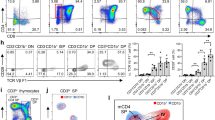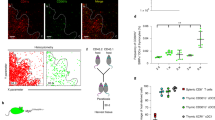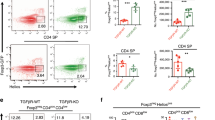Abstract
Hassall's corpuscles—first described in the human thymus over 150 years ago1—are groups of epithelial cells within the thymic medulla. The physical nature of these structures differs between mammalian species2. Although Hassall's corpuscles have been proposed to act in both the removal of apoptotic thymocytes3,4 and the maturation of developing thymocytes5 within the thymus, the function of Hassall's corpuscles has remained an enigma. Here we report that human Hassall's corpuscles express thymic stromal lymphopoietin (TSLP). Human TSLP activates thymic CD11c-positive dendritic cells to express high levels of CD80 and CD86. These TSLP-conditioned dendritic cells are then able to induce the proliferation and differentiation of CD4+CD8-CD25- thymic T cells into CD4+CD25+FOXP3+ (forkhead box P3) regulatory T cells. This induction depends on peptide–major histocompatibility complex class II interactions, and the presence of CD80 and CD86, as well as interleukin 2. Immunohistochemistry studies reveal that CD25+CTLA4+ (cytotoxic T-lymphocyte-associated protein 4) regulatory T cells associate in the thymic medulla with activated or mature dendritic cells and TSLP-expressing Hassall's corpuscles. These findings suggest that Hassall's corpuscles have a critical role in dendritic-cell-mediated secondary positive selection of medium-to-high affinity self-reactive T cells, leading to the generation of CD4+CD25+ regulatory T cells within the thymus.
This is a preview of subscription content, access via your institution
Access options
Subscribe to this journal
Receive 51 print issues and online access
$199.00 per year
only $3.90 per issue
Buy this article
- Purchase on Springer Link
- Instant access to full article PDF
Prices may be subject to local taxes which are calculated during checkout




Similar content being viewed by others
References
Hassall, A. H. The Microscopic Anatomy of The Human Body in Health and Disease (Samuel Highly, London, 1849)
Farr, A. G., Dooley, J. L. & Erickson, M. Organization of thymic medullary epithelial heterogeneity: implications for mechanisms of epithelial differentiation. Immunol. Rev. 189, 20–27 (2002)
Blau, J. N. A phagocytic function of Hassall's corpuscles. Nature 208, 564–567 (1965)
Blau, J. N. & Veall, N. The uptake and localization of proteins, Evans Blue and carbon black in the normal and pathological thymus of the guinea-pig. Immunology 12, 363–372 (1967)
Senelar, R., Escola, M. J., Escola, R., Serrou, B. & Serre, A. Relationship between Hassall's corpuscles and thymocytes fate in guinea-pig foetus. Biomedicine 24, 112–122 (1976)
Nishio, H., Matsui, K., Tsuji, H., Tamura, A. & Suzuki, K. Immunolocalization of the mitogen-activated protein kinase signalling pathway in Hassall's corpuscles of the human thymus. Acta Histochem. 103, 89–98 (2001)
He, W., Zhang, Y., Deng, Y. & Kabelitz, D. Induction of TCR-γδ expression on triple-negative (CD3-4-8-) human thymocytes. Comparative analysis of the effects of IL-4 and IL-7. J. Immunol. 154, 3726–3731 (1995)
Le, P. T., Lazorick, S., Whichard, L. P., Haynes, B. F. & Singer, K. H. Regulation of cytokine production in the human thymus: epidermal growth factor and transforming growth factor alpha regulate mRNA levels of interleukin 1α (IL-1α), IL-1β, and IL-6 in human thymic epithelial cells at a post-transcriptional level. J. Exp. Med. 174, 1147–1157 (1991)
Romagnani, P. et al. High CD30 ligand expression by epithelial cells and Hassall's corpuscles in the medulla of human thymus. Blood 91, 3323–3332 (1998)
Zaitseva, M. et al. Stromal-derived factor 1 expression in the human thymus. J. Immunol. 168, 2609–2617 (2002)
Annunziato, F. et al. Macrophage-derived chemokine and EBI1-ligand chemokine attract human thymocytes in different stage of development and are produced by distinct subsets of medullary epithelial cells: possible implications for negative selection. J. Immunol. 165, 238–246 (2000)
Watanabe, N. et al. Human thymic stromal lymphopoietin promotes dendritic cell-mediated CD4+ T cell homeostatic expansion. Nature Immunol. 5, 426–434 (2004)
Leonard, W. J. TSLP: finally in the limelight. Nature Immunol. 3, 605–607 (2002)
Soumelis, V. et al. Human epithelial cells trigger dendritic cell-mediated allergic inflammation by producing TSLP. Nature Immunol. 3, 673–680 (2002)
Friend, S. L. et al. A thymic stromal cell line supports in vitro development of surface IgM+ B cells and produces a novel growth factor affecting B and T lineage cells. Exp. Hematol. 22, 321–328 (1994)
Bender, J., Mitchell, T., Kappler, J. & Marrack, P. CD4+ T cell division in irradiated mice requires peptides distinct from those responsible for thymic selection. J. Exp. Med. 190, 367–374 (1999)
Ernst, B., Lee, D. S., Chang, J. M., Sprent, J. & Surh, C. D. The peptide ligands mediating positive selection in the thymus control T cell survival and homeostatic proliferation in the periphery. Immunity 11, 173–181 (1999)
Hsieh, C.-S. et al. Recognition of the peripheral self by naturally arising CD4+CD25+ T cell receptors. Immunity 21, 267–277 (2004)
Salomon, B. et al. B7/CD28 costimulation is essential for the homeostasis of the CD4+CD25+ immunoregulatory T cells that control autoimmune diabetes. Immunity 12, 431–440 (2000)
Tai, X., Cowan, M., Feigenbaum, L. & Singer, A. CD28 costimulation of developing thymocytes induces Foxp3 expression and regulatory T cell differenation independently of interleukin 2. Nature Immunol 6, 152–162 (2005)
Tarbell, K. V., Yamazaki, S., Olson, K., Toy, P. & Steinman, R. M. CD25+ CD4+ T cells, expanded with dendritic cells presenting a single autoantigenic peptide, suppress autoimmune diabetes. J. Exp. Med. 199, 1467–1477 (2004)
Stephens, L. A., Mottet, C., Mason, D. & Powrie, F. Human CD4+CD25+ thymocytes and peripheral T cells have immune suppressive activity in vitro. Eur. J. Immunol. 31, 1247–1254 (2001)
Sakaguchi, S. Naturally arising CD4+ regulatory T cells for immunologic self-tolerance and negative control of immune responses. Annu. Rev. Immunol. 22, 531–562 (2004)
Fontenot, J. D. & Rudensky, A. Y. Molecular aspects of regulatory T cell development. Semin. Immunol. 16, 73–80 (2004)
Jordan, M. S. et al. Thymic selection of CD4+CD25+ regulatory T cells induced by an agonist self-peptide. Nature Immunol. 2, 301–306 (2001)
Apostolou, I., Sarukhan, A., Klein, L. & von Boehmer, H. Origin of regulatory T cells with known specificity for antigen. Nature Immunol. 3, 756–763 (2002)
Malek, T. R., Yu, A., Vincek, V., Scibelli, P. & Kong, L. CD4 regulatory T cells prevent lethal autoimmunity in IL-2Rβ-deficient mice: Implications for the nonredundant function of IL-2. Immunity 17, 167–178 (2002)
Kyewski, B. & Klein, L. Self-antigen presentation by thymic stromal cells: a subtle division of labour. Curr. Opin. Immunol. 12, 179–186 (2000)
von Boehmer, H. Selection of the T-cell repertoire: receptor-controlled checkpoints in T-cell development. Adv. Immunol. 84, 201–238 (2004)
Bendriss-Vermare, N. et al. Human thymus contains IFN-α-producing CD11c+, myeloid CD11c+, and mature interdigitating dendritic cells. J. Clin. Invest. 107, 835–844 (2001)
Acknowledgements
We thank M. J. Finegold and K. Sternberg for tissue materials; E. Weider, Z. He and K. Ramirez for performing the cell sorting; B. Nortzon and M. Hajek for assistance in the preparation of the manuscript; and L. L. Lanier, S. Ullrich, M. F. Wilkinson and K. Schluns for critical reading and suggestions.
Author information
Authors and Affiliations
Corresponding author
Ethics declarations
Competing interests
Reprints and permissions information is available at npg.nature.com/reprintsandpermissions. The authors declare no competing financial interests.
Supplementary information
Supplementary Figures S1–S7
This file contains 7 Supplementary Figures showing that human TSLP expression in Hassall’s corpuscles (Fig. S1), two DC populations in human thymic medulla (Fig. S2), the generation of CD4+CD8-CD25+ cells induced by TSLP-DCs (Fig. S3-5), the molecules that caused TSLP-DCs to induce the generation of CD4+CD25+ TR cells (Fig. S6) and comparative analysis of TSLP-DC–generated CD4+CD25+ T cells from fetal thymus or adult peripheral blood (Fig. S7). (PDF 2093 kb)
Supplementary Figures Legends
Contains text descriptions to accompany the above Supplementary Figures (RTF 23 kb)
Rights and permissions
About this article
Cite this article
Watanabe, N., Wang, YH., Lee, H. et al. Hassall's corpuscles instruct dendritic cells to induce CD4+CD25+ regulatory T cells in human thymus. Nature 436, 1181–1185 (2005). https://doi.org/10.1038/nature03886
Received:
Accepted:
Issue Date:
DOI: https://doi.org/10.1038/nature03886
This article is cited by
-
Navigating the thymic landscape through development: from cellular atlas to tissue cartography
Genes & Immunity (2024)
-
Intrathymic dendritic cell-biased precursors promote human T cell lineage specification through IRF8-driven transmembrane TNF
Nature Immunology (2023)
-
Impact of disease-modifying therapy on dendritic cells and exploring their immunotherapeutic potential in multiple sclerosis
Journal of Neuroinflammation (2022)
-
The role of dendritic cells in the immunomodulation to implanted biomaterials
International Journal of Oral Science (2022)
-
Thymus and autoimmunity
Seminars in Immunopathology (2021)
Comments
By submitting a comment you agree to abide by our Terms and Community Guidelines. If you find something abusive or that does not comply with our terms or guidelines please flag it as inappropriate.



